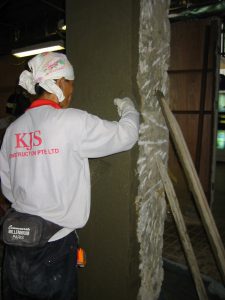Plaster and Skimcoat
Property



Components
The base for plaster is either gypsum, lime or cement. However, lime is not commonly used in Singapore because of delamination problem.In Singapore, usually plaster comes in pre-pack form (includes X-Ray Protection plaster, Acoustic Plaster, etc) and will be mixed with water on site prior to application.
The basic component of plaster is as follow:
Gypsum
Complying to CP56: 1991 or BS 1191 Part 1 and 2
- Premixed lightweight plaster
- Includes undercoat plaster (browning, metal lathing, and bonding plaster) and finish plaster (final coat plaster).
- Lightweight plaster
- Class A: Plaster of Paris, suitable for patching/ repair work and for fibrous plaster work.
- Class B: Retarded hemi hydrate gypsum plaster, includes undercoat plaster (browning, and metal lathing), and finish plaster (final coat plaster).
- Class C: Anhydrous gypsum plaster, used as final coat only
- Class D: Keene’s plaster, used as a neat final coat plaster only.
Cement
Portland cement to SS 26, Portland-blast furnace cement to BS 146, high alumina to BS 915, and masonry cement to BS 5224.
- Premixed lightweight plaster
- The mix proportion of plaster is 1:3-4 (cement: sand).
Aggregate
Dense aggregate refers to sand used for plastering (complies with BS 1199) and lightweight aggregate includes perlite and vermiculite (complies with BS 3797).
Water
Bonding agent

- Emulsion of PVAC (BS 5270); can be used on soffits or walls.
- Bituminous solutions or emulsion; not for soffits.
Admixture
Should comply with BS 4887.
Synthetic Fibers
Suitable synthetic fibers, clean, dry, and free from oil.
Lathing
Used as background for plastering when necessary.
Scrim

It is used to reinforce joints e.g. pc wall to pc wall, and where cracks are likely to occur on plaster. Comes in wire mesh form.
| Density | 1500-1800 kg/m³ |
| Thermal Conductivity (K) | 0.66 W/mK |
| Recommended Thickness | Up to 20mm |
| Tensile Strength | >0.75 N/mm² |
| Compressive Strength | 12-25 N/mm² |
| Resistance to Moisture | The plaster will deteriorate if applied onto damp backgrounds or if used unprotected in damp environments. Careful attention to detail is required in kitchens, bathrooms, shower areas, etc. |
| Drying | Drying times vary considerably with the ambient conditions, applied thickness and the suction of the background. In ideal conditions, a 15mm thick topcoat will be dry after 3-4 days.
To encourage controlled drying, ensure plastered areas are well ventilated Excess heat or forced ventilation may cause cracking. If cracking occurs, the affected area can be wetted and re-toweled.Each coat should be allowed to dry before applying further coats. |
| Fire Resistance | Plasters are non-combustible material as defined in BS 476: part 4. Therefore, they are categorized as Class 0 in accordance with the requirement of ‘Fire Precaution for Buildings’, which allows them to be used without restriction as a surface finishing material. |
| UV Resistance | Plaster is UV resistant, in terms of colour-fastness. |
| Resistance to Biological Growth | Such mildew or fungal growth is due to dampness and poor air circulation, plus the presence of fungal spores.
The mould growth should be scraped off, a fungal mould inhibitor applied and the work dried out by air circulation. |